|
|
| FoAR | 一种源于传统竹编技艺的建筑器物运算化设计方法 |
|
论文标题:A computation design method for architectural artifacts adapted from traditional Kagome bamboo basketry techniques
期刊:Frontiers of Architectural Research
作者:Hiroyuki Shinohara , Tung Hoi Peter Chan
发表时间:23 Apr 2024
DOI:10.1016/j.foar.2023.11.007

FoAR是由高等教育出版社和东南大学建筑学院联合主办的全英文学术期刊
建筑学 / 城乡规划 / 风景园林
本刊已被 A&HCI / CSCD / Scopus / DOAJ / CSTPCD 收录
Frontiers of Architectural Research(建筑学研究前沿/FoAR)于4月初在线发布了2024年第二期,共12篇文章。本期推送为其中一篇文章的摘要和大纲,内容采用中文表达,方便大家阅读。推文内容不可直接引用。感兴趣的读者,请点击文末左下方“阅读原文“,可免费浏览及下载原版英文论文。
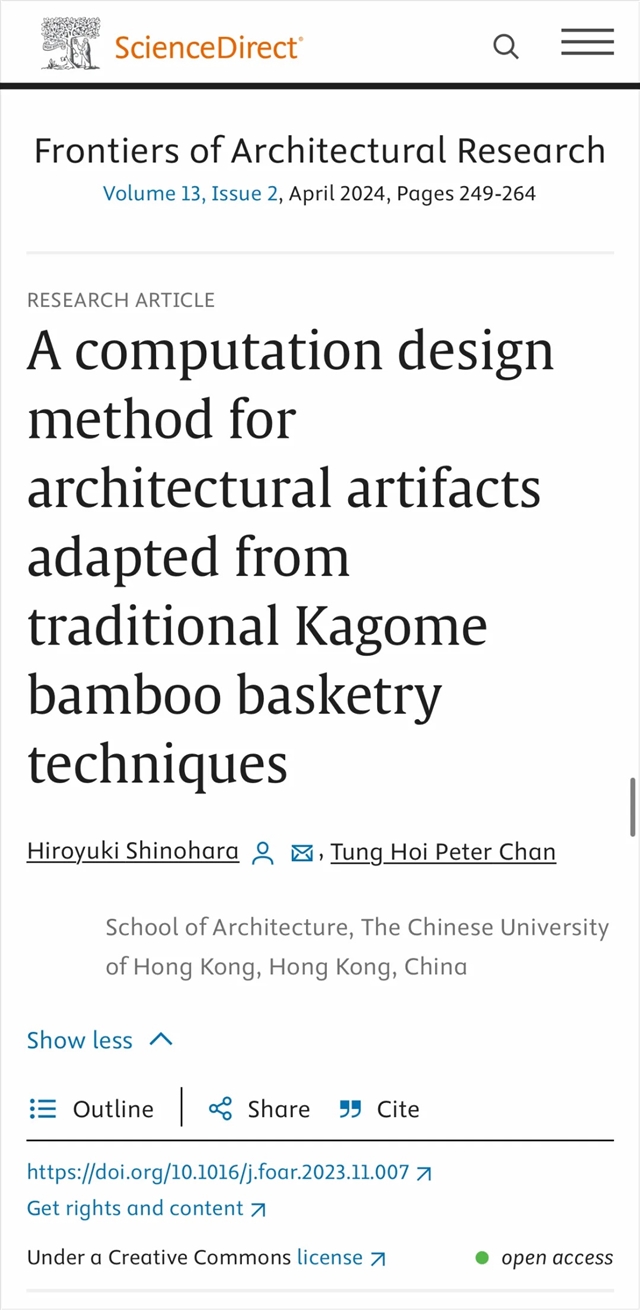
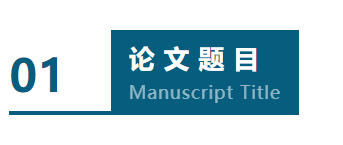
A computation design method for architectural artifacts adapted from traditional Kagome bamboo basketry techniques
一种源于传统竹编技艺的建筑器物运算化设计方法

Hiroyuki Shinohara*, Tung Hoi Peter Chan
School of Architecture, The Chinese University ofHong Kong,Hong Kong, China
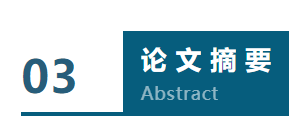
This study is a digital form-finding and manual fabrication experiment in woven architectural design, with one traditional weaving style, Kagome, used to scale the craft up into an architectural-scale bamboo woven artifact. Kagome is a tri-hexagonal pattern employed in traditional bamboo basketry as a triaxial weaving system, resulting in an object with a selfbracing capacity without the use of fasteners owing to its interlacing lattices. Although existing studies and tools have addressed triaxial weaving design and representation, the current consideration of the advantages of weaving with bamboo is insufficient. To address this research gap, this study develops a computational design method based on studies on bamboo basketry. This allows for the representation and exploration of design geometries using combinations of regular triangular meshes for the fabrication of Kagome woven bamboo artifacts. A full-scale mock-up was fabricated to evaluate the effectiveness of the method. The mock-up demonstrated the self-bracing properties of Kagome, but there were discrepancies between the mock-up and the design. Factors affecting bamboo weaving on an architectural scale have been identified within this study to inform future research on woven bamboo structures.
本研究是一项关于建筑编织设计的运算化找形分析与手工制作实验,编织风格为传统的笼目样式(Kagome,意指编织篮中的孔眼图案),是扩大到建筑物尺度的竹编器物。笼目是传统竹编篮筐中常使用到的三六边形(tri-hexagonal)图案(属于三轴编织系统)。由于其交错的格子,使其具备自支撑能力,而无需再使用紧固构件。虽然现有的研究和工具已经解决了三轴编织的设计与呈现,但是目前对竹编编织优势的考量还是不够的。为了弥补这一研究空白,本文发展出一种基于竹编研究的计算设计方法——使用等边三角形网格的组合来呈现和探索几何图形的设计,从而制成笼目样式的竹编器物。作者制作了一个原尺寸的实体模型来评估该方法的有效性。该模型展示了笼目的自支撑特性,但模型与设计之间还是存在些许差异。本文最终确定了影响建筑尺度上竹编工艺的因素,也为未来竹编建构的研究提供了一些思考。

Traditional bamboo craft / 传统竹编工艺
Triaxial material interlacing / 三轴材料交织
Bamboo / 竹子
Computational design methods / 运算化设计方法
Mesh block combination system / 网格块组合系统
Architectural woven artifact / 建筑编织器物

1. Introduction / 引言
2. Research context / 研究背景
2.1. Properties and principles of Kagome weaving basketry / 笼目编织篮的性能和原理
2.2. Triaxial weaving on an architectural scale / 建筑尺度上的三轴编织
2.3. Recent approaches to Kagome weaving computation and fabrication / 关于笼目编织计算与制造的最新方法
3. Methodology / 研究方法
4. Findings / 发现
4.1. Analysis of traditional bamboo basketry / 传统竹编篮筐分析
4.2. Translation of the basket into a digital model / 将篮筐转化为运算化模型
4.3. Mesh Block Combination System for bamboo woven artifacts on an architectural scale /使用网格块组合系统制作建筑尺度上的竹编器物
4.3.1. Creation of mesh blocks / 创建网格块
4.3.2. Combination of mesh blocks and introduction of singularities / 组合网格块及引入奇点
4.4. Physical mock-up / 实物模型
4.4.1. Testing with the digital model and construction of the full-scale mock-up / 运算化模型测试和全尺寸模型的构建
4.4.2. Deformation record / 变形记录
4.4.3. Deformation analysis / 变形分析
4.4.4. Other observations / 其它观察结果
5. Discussion / 探讨
6. Conclusion / 结论

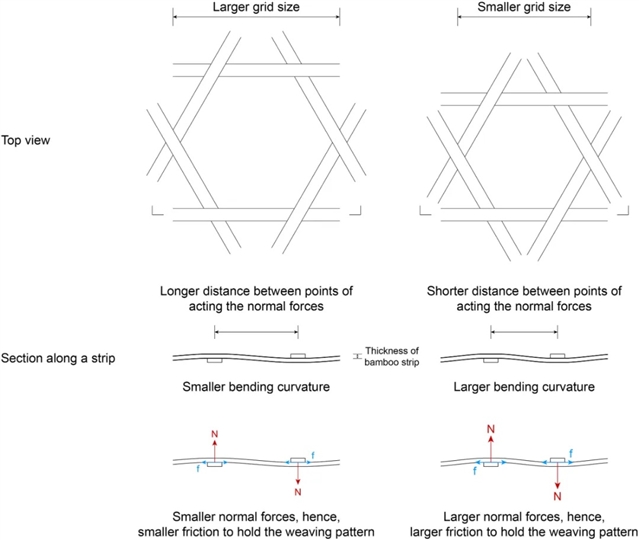
▲ 图一:竹篮编织中网格尺寸与力的关系。 © 本文作者

▲ 图二:笼目图案的再现与再生。 © 本文作者

▲ 图三:将竹篮编织转化成运算化模型。 © 本文作者
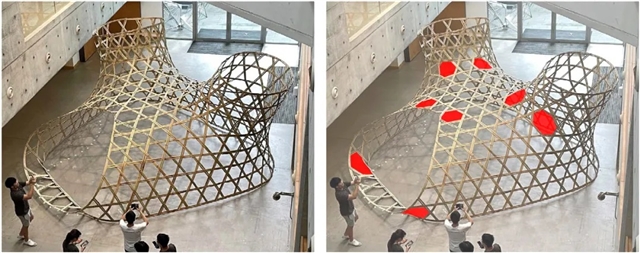
▲ 图四:全尺寸模型,结合壳结构和两个管网作为孔,在入口处有环形带。奇点用红色标识。 © 本文作者
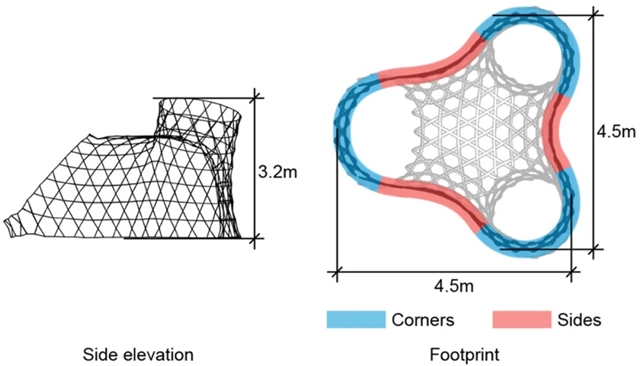
▲ 图五:模型的设计。 © 本文作者
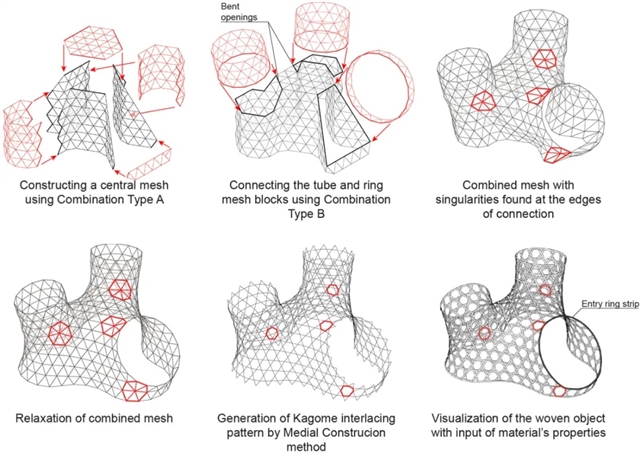
▲ 图六:网格块组合系统中A、B两种组合类型全尺寸模型的设计过程。 © 本文作者
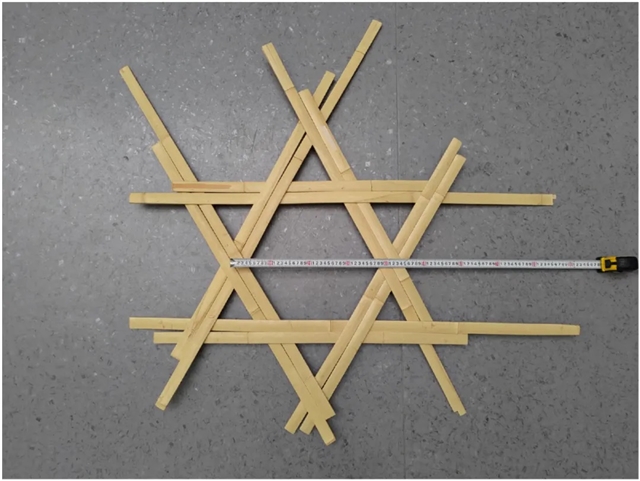
▲ 图七:紧密编织网格尺寸的物理测试。 © 本文作者
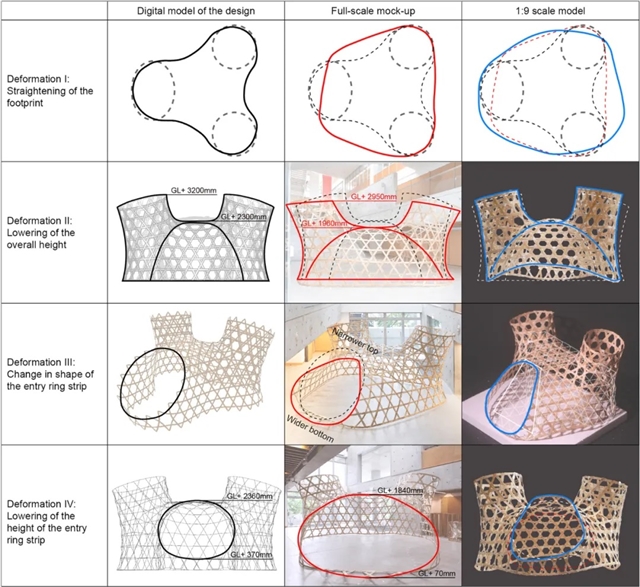
▲ 图八:比较研究运算化模型的设计、全尺寸实物模型和 1:9 比例模型在四个区域的变形情况。 © 本文作者


Hiroyuki Shinohara
Assistant professor
School of Architecture, The Chinese University ofHong Kong
Hong Kong, China
Hiroyuki Shinohara is an Assistant Professor at the School of Architecture of the Chinese University ofHong Kong(CUHK). Before joining CUHK, he was an Assistant Professor in Architecture and Built Environment at the University of Nottingham, Ningbo.
Before joining academia, Hiroyuki practised at international architecture firms as a lead designer. At AECOM, Shanghai, he was an Associate Director and led teams in Architecture and Urbanism for integrated architecture and urban design projects. At Perkins & Will, Shanghai, he was the Director of Design Practice in charge of architectural design, quality assurance, and delivery of projects.
With diverse experiences in practice, Hiroyuki engages in teaching and academic research at CUHK. His current research direction brings together craft, material, and technology to evaluate and upgrade the use of local materials and traditional making techniques for contemporary architectural design. He also researches on type and typology and the idea of the city, examining the dominant architectural types of cities and their social implications. In his Ph.D., Hiroyuki studied Japanese architects’ uses of onomatopoeias in their textual descriptions. The research points to the Japanese architects’ use of the ordinal sound-based words particular to the Japanese language that results in the production of sensible and tangible spaces in Japanese architecture. The research contributes to the study of language in architecture by connecting the study of language to materiality instead of formality.

Tung Hoi Peter Chan
Research Assistant
School of Architecture, The Chinese University ofHong Kong
Hong Kong, China
I work as an architectural designer and researcher graduated with a Bachelors degree in Social Science (Architecture) from CUHK in 2022. I am also a craftsman with over a decades experience, especially specializing in timber and bamboo. Latest projects include Moving Bamboo inHong KongPavilion in Venice Biennale of Architecture 2023.
Other interests include physics, zoology and general science, humanity arguments, reading, popular music, etc.


长按上方二维码|浏览本期精彩论文
▼ 点击下方词条 | 往期精彩不容错过
#期刊快讯#系列
1/ 主编王建国院士团队荣获国家科技进步奖一等奖
2/ FoAR|2021年度报告,2022新年快乐!
3/ FoAR|2022年度报告,2023新年快乐!
4/ FoAR|2023年度报告,2024新年快乐!
5/ 最新|FoAR 2022 CiteScore 指数上升为4.7
6/ 2022年度JCR发布|FoAR 首获影响因子 3.5,位列建筑领域期刊第一
7/ 最新|FoAR 被中国科技论文与引文数据库(CSTPCD)收录
8/ 最新|FoAR 再次入选中国国际影响力优秀学术期刊
9/ 最新|FoAR 荣获科爱十大优秀期刊奖
10/ 最新|FoAR进入2023年中科院分区表1区
#新刊上线#系列
2024年第一期
2024年第二期
#FoAR投稿指南#系列
1/ 投稿流程
2/ Guide for Author中文版
3/ 审稿流程及发表流程
4/ 如何提交修改稿
5/ 录用文章出版流程
#期刊知识科普#系列
1/ SCI之父尤金·加菲尔德的传奇人生
2/ 国际核心期刊数据库大解析
3/ 手把手教你如何使用最强工具Web of Science
4/ 如何发现一本好期刊
5/ 国内核心期刊有哪些
6/ 版面费与期刊影响力
#精彩文章#系列精选
01/ 城市设计实践发展的多元维度——基于UAL的案例研究
02/ 从智慧城市到共情城市
03/ 传统阿拉伯伊斯兰城市居住区形态学:以传统城市大马士革为例
04/ 建筑遗产预防性保护的意大利视角
05/ 生物与建筑:将科学知识与设计实践相结合的六家法国建筑事务所项目案例研究
06/ 颇具争议的渐进式改造:Elemental建筑事务所金塔蒙罗伊公屋居住区项目的15年
07/ 联合眼动实验和SD法的传统商业街区视觉效果感知评价
08/ 历史的层次:古城堡遗迹中的新建筑改造
09/ 通过空间句法检验帕拉第奥别墅平面中的控制性、中心性和灵活性
10/ 自1931年柯布西耶的Salubra色卡问世后其建筑色彩的偏好:一种跨文化的分析
11/ 建筑师身份的描绘:1920年代末的中国美术建筑师——刘既漂
12/ 探索暴露于风影响下织物的表达与功能
13/ 绿色屋顶能否在地中海气候条件下显著节约能源?基于不同案例的批判性评估
14/ 芬兰近期落成的原木建筑的建构及建筑品质:相关建筑师的解读
15/ 新加坡高校教室光环境品质研究

《前沿》系列英文学术期刊
由教育部主管、高等教育出版社主办的《前沿》(Frontiers)系列英文学术期刊,于2006年正式创刊,以网络版和印刷版向全球发行。系列期刊包括基础科学、 、工程技术和人文社会科学四个主题,是我国覆盖学科最广泛的英文学术期刊群,其中12种被SCI收录,其他也被A&HCI、Ei、MEDLINE或相应学科国际权威检索系统收录,具有一定的国际学术影响力。系列期刊采用在线优先出版方式,保证文章以最快速度发表。
中国学术前沿期刊网
http://journal.hep.com.cn

特别声明:本文转载仅仅是出于传播信息的需要,并不意味着代表本网站观点或证实其内容的真实性;如其他媒体、网站或个人从本网站转载使用,须保留本网站注明的“来源”,并自负版权等法律责任;作者如果不希望被转载或者联系转载稿费等事宜,请与我们接洽。